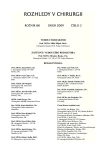Gastric Carcinoma Surgery Outcomes during 2004–2008
Authors:
R. Vrba; Č. Neoral; R. Aujeský; T. Malý; M. Loveček
Authors‘ workplace:
I. chirurgická klinika FN Olomouc, přednosta: doc. MUDr. Č. Neoral, CSc.
Published in:
Rozhl. Chir., 2009, roč. 88, č. 2, s. 50-54.
Category:
Monothematic special - Original
Overview
Gastric carcinoma is a malignancy, frequently manifesting itself in late stages, with metastatic spread into lymph nodes. Resection is the only curative therapy. A total of 149 gastric carcinoma patients were operated in the Ist Surgical Clinic during the studied five - year period. The pre-operative disease staging included the PET-CT examination, as a standard. Total gastrectomy (GE) was completed in 109 subjects, while 12 subjects underwent subtotal GE. The both procedures included D2 lymphadenectomy. In selected cases, the surgery included upper polar resection (7 subjects). Paliative resections or explorations were performed in 21 subjects. During the postoperative period, no complications were recorded in 90% of the patients, however, two subjects exited. The postoperative complications recorded included adhesive ileus in a single subject, subphrenic absces in two subjects, esophago-jejuno-anastomosis fistule in 8 subjects and a duodenal stub fistule in one female patient. Total or subtotal gastrectomy with D2 lymphadenectomy are standard procedures in gastric carcinoma patients. Mortality and morbidity rates of radical surgical procedures for gastric carcinoma should correspond with data presented in the literature.
Key words:
gastric carcinoma – surgery – lymphadenectomy
Sources
1. Berrino, A., Haas, O., Piard, F., et al. How many nodes must be examined to accurately stage gastric carcinomas? Cancer, 2002, 94, p. 2862–2866.
2. Becker, H. D., Hohenberger, W., Junginger, T., Schlag, P. M. Chirurgická onkologie. Grada, 2005, s. 291–338.
3. Devessa, S. S., Silverman, D. T., Young, J. L., et al. Cancer incidence and mortality trends among whites in the United States, 1947-1984. J. Nat. Cancer Indy., 1987, 79, 701–742.
4. Bonenkamp, J. J., Songun, I., Hermans, J., Sasako, M., Welvaart, et al. Randomised comparison of morbidity after D1 and D2 disection for gastric cancer in 996 Dutch patiens. Lancet, 1995, 345, 745–748.
5. Brady, M. S., Rogatko, A., Dent, L. L., Shiu, M. H. Effect of splenectomy on morbidity and survival followin curative gastrectomy for carcinoma. Ann. Surg., 1991, 126, 359–364.
6. Bozzetti, F., Marubini, E., Bonfani, G., et al. Total versus subtotal gastrectomy. Surgical morbidity and mortality rates a multicenter Italian randomized trial. Ann. Surg., 1997, 226, 613–620.
8. Malý, T., Zonča, P., Neoral, Č., Jurytko, A. Rekonstrukce po gastrektomii. Rozhledy v chirurgii, 2008, 7, 367–375
7. Roder, J. D., Bottcher, K., Siewert, J. R., Busch, R., Hermanek, P., Meyer, H-J. Prognostic factors in gastric carcinoma. Results of the German gastric carcinoma Study 1992. Cancer, 1993, 72, 2089–2097.
9. Gatěk, J., Duben, J., Bakala, J., Miča, T., Dudešek, B., Haša, E., Musil, T., Hnátek, L. Lymfadenektomie u časného karcinomu žaludku. Rozhledy v chirurgii, 2004, 9, 428–438
10. Sobin, L., Wittekind, Ch. UICC TNM Classification of malignant tumours. 1997, 5th ed., 56.
11. Manzoni, G., Verlato, G., Guglielmi, A., Laterza, E., Genna, M., Cordino, C. Prognostic significance of lymph node dissection in gastric cancer. Br. J. Surg., 1996, 83, 1604–1607.
12. Roukos, D. H, Lorenz, M., Enckle, A. Evidence of survival benefits of extended (D2) lymphadenectomy in Western patients with gastric cancer based on new concept: a prospect long-term follow-up study. Surgery, 1998, 123, 573–578.
13. Siewert, J. R., Bottcher, K., Roder, J. D., Busch, R., Hermanek, P., Meyer, H. J. and the German Gastric Carcinoma Study group Prognostic relevance of systematic lymph node dissection in gastric carcinoma. Br. J. Surg., 1993, 80, 1015–1018.
14. Buhl, K., Lehnert, T., Schlag, P., Herfarth, C. Reconstruction after gastrectomy and quality of life. World J. Surg., 1995, 19, 558–564.
15. Griffith, J. P., Sue-ling, H. M., Martin, I., et al. Preservation of the spleen improves survival after radical surgery for gastric cancer. Gut, 1995, 36, 684–690.
16. Okajima, K., Isozaki, H. Splenectomy for treatment of gastric cancer: Japanese experience. World J. Surg., 1995, 19, 537–540.
17. Wanebo, H. J., Kennedy, B. J., Winchester, D. P., Steward, A. K., Fremgen, A. M. Role of splenectomy in gastric cancer surgery: adverse effect of elective splenectomy on longterm surfoval. J. Am. Coll. Surg., 1997, 185, 177–184.
19. Šimša, J., Leffler, J., Hoch, J., Schwarz, J., Bavor, P. Karcinom žaludku a D2 lymfadenektomie – technika, možné komplikace., Rozhledy v chirurgii, 2004, 1, s. 6–10.
20. Yonemura, Y., Wu, C. C., Fukushima, N., Honda, I., Bandou, E., Kawamura, T., Kamata, T., Kim, B. S., Matsuki, N., Sawa, T., Nosh, S. H., East Asia Oncology Group Randomized clinical trial of D2 and extended paraaortic lymphadenectomy in patients with gastric cancer. Int. J. Clin. Oncol., 2008, 13, 132–137.
21. Sasako, M., Sano, T., Yamamoto, S., Kurokawa, Y., Nashimoto, A., et al. D2 lymphadenectomy alone or with paraaortic nodal dissection for gastric cancer. N. Engl. J. Med., 2008, 31, 448–451.
22. Ondrák, M., Šefr, R. Role PET a CT vyšetření v managmentu léčby zhoubného onemocnění tlustého střeva a konečníku – review. Rozhledy v chirurgii, 2007, 9, 461–465.
23. ÚZIS Novotvary 2005.
24. Stefanová, M. Epidemiologie, screening, současná diagnostika a staging karcinomu žaludku. Bulletin HPB, 2008.
Labels
Surgery Orthopaedics Trauma surgeryArticle was published in
Perspectives in Surgery

2009 Issue 2
- Metamizole at a Glance and in Practice – Effective Non-Opioid Analgesic for All Ages
- Metamizole vs. Tramadol in Postoperative Analgesia
- Safety and Tolerance of Metamizole in Postoperative Analgesia in Children
Most read in this issue
- Radiographic Evaluation of Scapula Fractures
- Traumatic Perforation of the Duodenum – A Case Review
- A Double Penetration Wound of the Thoracic Wall in an Afghan Military Policeman
- Ischemia-reperfusion Injury in Kidney Transplantation from Non-heart Beating Donor – Do Antioxidants or Antiinflammatory Drugs Play Any Role?
